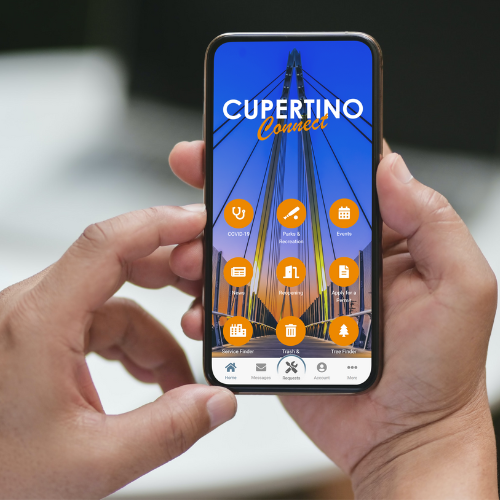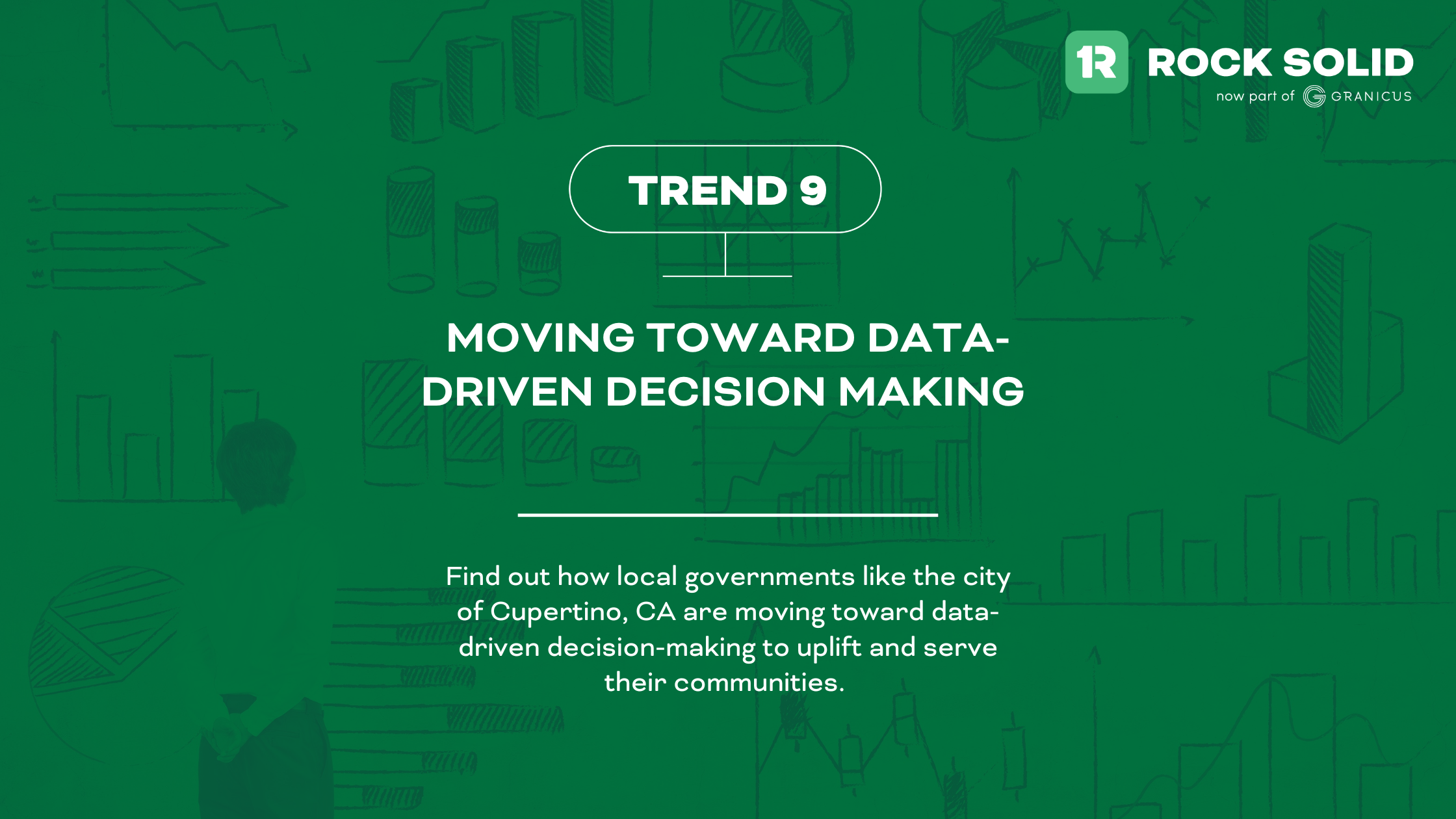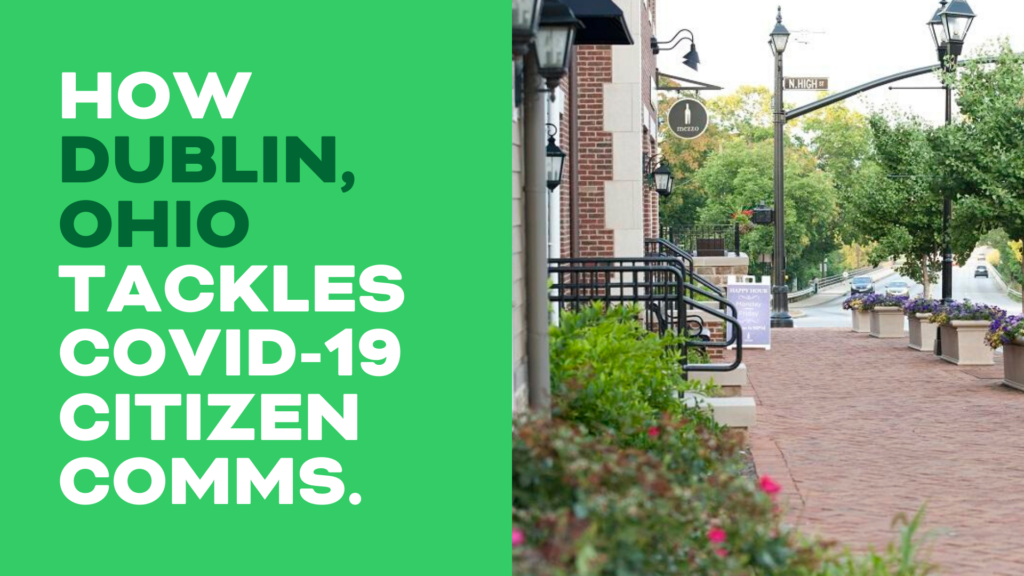When we think about the future, it’s easy to prioritize positive advancements when goal setting. I mean think about it, we’re always planning goals for the new year, or we end up promising ourselves that will for sure start that Peloton workout next Monday. Either way, positive goal-setting is imperative to positive goal-achieving, and in today’s advanced technological era- there are even more ways to make smarter goals and decisions when planning for the future.
In Rock Solid’s latest report, we uncover 9 Trends in Citizen Engagement for Local Government in 2023, showcasing the trends that local government should be on the lookout for in the coming year. Supplied with stories from other local governments being early adopters of these trends, the report serves as a reference for what to expect for citizen engagement in 2023- and examples of how your peers are using these trends to accelerate their communities.
The last trend in the report (but certainly not the least) is Trend 9: Moving Toward Data-Driven Decision Making, and this trend carries a lot of weight for local government and citizen engagement planning. After all, we know that constituents and department heads love when there’s data behind decisions being made- it helps add validity to the time, money, and resources local governments spend for citizen engagement. In this blog, we will uncover three stories of how your peers are utilizing Moving Toward Data-Driven Decision Making, in the hope to help your community adapt to this trend too.
STORY 1: Department of Justice’s (DoJ’s) Office of Justice Programs (OJP) Improving Summer Grant Seasons Operations
Though this example doesn’t come from a local government background, the story offers validity that can translate to smaller communities looking to improve internal processes for projects.
During the summer, the Department of Justice’s (DoJ’s) Office of Justice Programs (OJP) is on a tight time crunch. This is when “OJP distributes most of its public safety grants, totaling roughly $2 billion each year, to more than 2,000 grantees.1 OJP personnel still call this “red-book" season,” a term dating from times when all grant applications were recorded in huge red binders.” (Deloitte Insights)
A 15-year-old veteran of OJP, Lara Allen says, “Everything stops during those two to three months—it’s all hands on deck to deal with the number of grant applications that come in that very short timeline,” This time-consuming effort created an opportunity to move toward operational data, instead of depending on intuition." (Deloitte Insights)
“OJP began pulling disparate data systems together and automated its review processes to increase the accuracy and consistency of its decisions while reducing the burden on its grant managers. The new processes had demonstrable impacts. Grant reviews can now be performed quarterly rather than annually. The time needed for grant managers to capture grantee data in OJP’s database has been slashed from 30 minutes to almost zero. These improvements led to more accurate decisions and gave the entire office more confidence in its actions.4” (Deloitte Insights) Through the integration of data-driven decision-making, OJP was able to shift toward objective grant decisions- which is always positive, no matter if federal, state, or local government.
STORY 2: The City of Cupertino, CA Creates Transparency through Data with Rock Solid
The next story comes from the sunshine state of California, the city of Cupertino was looking for a way to be more transparent with its residents and staff within its 311 operations as part of a city-wide focus on data. The city had dashboards for a variety of local government services, from PCI to Tree Services, 311 services, however, could not provide the same level of transparency. Though local governments provide many valuable services to citizens, 311 services tend to be the “meat” of transparency in serving the community, making it important for residents to have easy channels of access to this service.
In the prior system, resident visibility into the status of projects was limited, and customer service suffered. This system did not integrate with Cityworks, which was a huge execution and visibility pain point. Service requests could not be tracked in aggregate, being sent directly to personal email inboxes when tasks came in, which was stressful for staff. Department leaders and staff were not able to track requests, resolution times, and team assignments in aggregate.

The city then chose data-driven government solutions: Rock Solid’s OneView CRM, OneLink mobile app, and APIs integrated directly with Cityworks in real time, bringing all service requests into the city's existing workflow. A Cupertino Connect app is free to download on the Apple App Store and Google Play Store and lets residents submit service requests or connect with city resources via smartphone or web widget. APIs also allowed the Cupertino Connect system to function within other city applications, including Cupertino’s tree inventory website. Cupertino Connect allowed residents to submit 311 requests, see existing requests in their area, track progress and receive communication from city staff surrounding their requests, and more. These integrations and APIs allowed important 311 engagement data to flow out of the CRM and into data visualization applications like Microsoft Power BI. These dashboards shared 311 data with residents on a publicly available web page to promote transparency. Department leaders and staff used an internal 311 dashboard to track, measure, and improve service delivery. Through the data-driven government solution, Cupertino was able to create an unparalleled level of transparency for serving its constituents.
STORY 3: Cranbrook, BC Improves Customer Service and Generates Public Works Efficiency
So the next story is a little similar to story number 2, but... at least we’ll have less ground to cover! The city of Cranbrook, BC, was looking for a way to better communicate with its citizens as part of a 311 call center initiative. The only way citizens could submit service requests was by calling a standard, non-311 number. Call takers would then add requests manually. This process often led to confusion between city departments and long hours spent on the phone transferring information. This may sound a bit familiar to story 1 from the Department of Justice’s (DoJ’s) Office of Justice Programs (OJP), (long processes, staff burdens, you get the drift.)
Tony Hetu, Deputy Director of Public Works for the city of Cranbrook explains some of the areas of opportunity for new communication systems:
“We’d have a light out, and we’d try to take a description from the caller on exactly where that light is. And we were forever sending out electricians to the wrong light, or to troubleshoot the wrong area,” “Only so much information can be shared over the phone. And feedback on the completion of service requests wouldn’t go back to the caller.”
Much like Cupertino, Cranbrook partners with Rock Solid to provide a mobile citizen request solution for citizens and staff. Rock Solid’s app and systems connect directly with Cityworks, Cranbrook’s asset management system. This two-way transfer of information happens in real-time and brings all mobile service requests into the city’s existing workflow.
The Cranbrook 311 app has been available for download on the Apple App Store since going live in 2017. It is free for citizens and easy to use to submit service requests or connect with city resources via smartphone.

For citizen engagement, Rock Solid helps Cranbrook connect with residents in a modern format--mobile.
Hetu says, “Rock Solid helped us solve the mobile challenge. It connects with and populates our service request system without having to use a VPN for security. It helped us avoid that extra layer of security and simplified the system to avoid long-term IT involvement.”
The city’s data-driven app positively affects customer service, internal processes, and operations. The city experienced a 36% better service resolution time too, illustrating how moving toward data-driven solutions can help internal efficiencies.
"The really nice piece is that the system automatically sorts requests and sends them to the right department head. That bypasses about two steps that we had before. It saves a lot of time,” says Hetu.
Bottom Line:
In general, decisions that come from a place of information and data end up having more of a positive impact long term. I mean, at least if we’re looking at the three stories shown above. Data is especially important when it comes to decisions for governments: federal, state, and local. By releasing objectivity and intuition from decision-making, governments have the chance to better serve their communities and make better use of time, money, and resources without any guessing. In our latest comprehensive report, Rock Solid covers the other 8 trends in citizen engagement to look out for in the new year. Learn more stories and trends and download the full report today.



